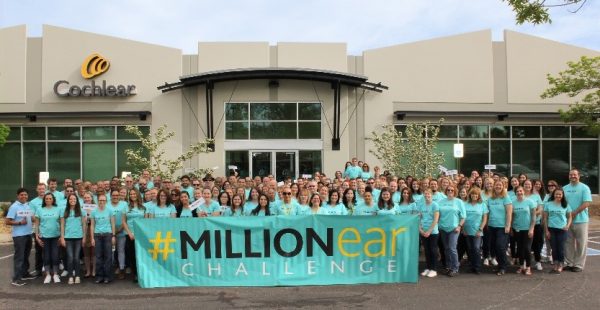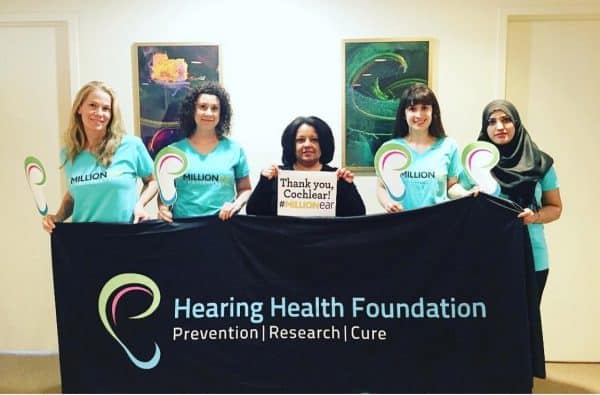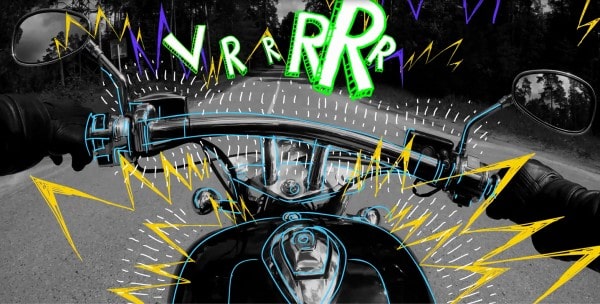We did it! We exceeded our #MillionEar Challenge 2018 goal, reaching more than 1 million ears in just 31 days. Many thanks to all who joined the cause! Your participation will impact the ears you care about through the Hearing Health Foundation’s Emerging Research Grants (ERG) program.
The challenge was to bring hearing health awareness to more than 1 million people during the month of May—Better Hearing and Speech Month—with our annual #MillionEar Challenge and all-new “See Sound Differently” video, and we’re excited to report we did just that!
A total of 100,346 people took the challenge in helping us inform a million ears about the importance of hearing health.
To all those who participated, thank you! You wore your #MillionEar Challenge t-shirts proudly. You changed your social media profile photo to support the cause. You watched the “See Sound Differently” video over 44,000 times and shared it with your networks. You encouraged your friends and family to take the free online hearing health assessment. For an entire month, you so selflessly dedicated yourselves to helping others realize the impact of hearing loss in hopes of preventing it from becoming a worldwide epidemic in the years to come.
Through the power of technology and social media, your efforts helped us reach well over one million people!

Hearing Health Foundation & Million Ear Challenge
Here’s the best part: Cochlear will contribute $30,000 to the Hearing Health Foundation’s Emerging Research Grants (ERG) program, and thanks to your generosity, we are able to donate additional proceeds through #MillionEar Challenge t-shirt sales. The ERG program annually awards grants to up-and-coming scientists who research under-funded and under-researched hearing disorders. For 60 years, the ERG program has helped propel innovative research and the careers of tomorrow’s hearing health innovators.
“Awareness is at the heart of Hearing Health Foundation’s efforts to prevent, treat, and cure hearing loss. I am deeply grateful Cochlear is committed to raising awareness of hearing loss, which will inspire more to pursue hearing tests and life-changing treatments,” said Nadine Dehgan, Chief Executive Officer, Hearing Health Foundation.
Here’s what Tony Manna, President of Cochlear Americas, had to say: “The continued rise of hearing loss is staggering, and the World Health Organization (WHO) suggests half of all cases of hearing loss can be prevented. At Cochlear, we are committed to raising awareness about hearing health and hearing loss prevention, educating people about the innovative technology available to treat hearing loss and funding hearing loss research to help address this global public health issue. We want everyone to live a full life and hear the sounds that fill them for a lifetime.”

Preventing noise-induced hearing loss
This year, we focused our #MillionEar Challenge message around prevention of noise-induced hearing loss, which is more widespread than you might think. In fact, more than 1 billion young people (12-35 years) are at risk of hearing loss due to recreational exposure to loud sounds.1 Through the “See Sound Differently” video, we wanted people to learn the about everyday sounds that can hurt hearing and to understand that even minimal exposure to certain noises can lead to hearing loss.
Here are some examples:
- Sporting events at 100 dB can be dangerous after 15 minutes2
- Headphones on max volume at 106 dB can be dangerous after 4 minutes3
- Concerts at 115 dB can be dangerous after 30 seconds4
You may be thinking: “But, I love going to concerts, listening to music and cheering on my favorite team.”
Don’t sweat it. You can still enjoy your favorite activities by taking these three simple steps to protect your ears:
- Lower the volume
- Move away from noise
- Wear hearing protection
As many of our recipients know, there are certain sounds in life that are worth protecting your ears for. Here are just a few:
Haven’t seen the “See Sound Differently” video? Click the image below to watch & share:
Want to monitor the noise levels in your everyday life? Download a free smartphone app that will act as your own personal sound meter.
- Deafness and hearing loss fact sheet [Internet]. World Health Organization; c2018 [cited 5 March 2018]. Available from: https://www.who.int/mediacentre/factsheets/fs300/en/
- What Noises Cause Hearing Loss? [Internet]. Centers for Disease Control and Prevention; c2017 [cited 13 March 2018]. Available from: https://www.cdc.gov/nceh/hearing_loss/what_noises_cause_hearing_loss.html.
- Noise pollution. Learn how to protect your ears! [Internet]. Hearing Loss Association of America; c2018 [cited 13 March 2018]. Available from: https://hearingloss.org/hearing-help/hearing-loss-basics/prevention/.
- Ambient noise. The background noise of the sea. [Internet]. United States Naval Academy; c2018 [cited 13 March 20180. Available from: https://www.usna.edu/Users/physics/ejtuchol/documents/SP411/Chapter11.pdf
- What Noises Cause Hearing Loss? [Internet]. Centers for Disease Control and Prevention; c2017 [cited 13 March 2018]. Available from: https://www.cdc.gov/nceh/hearing_loss/what_noises_cause_hearing_loss.html.
- Noise pollution. Learn how to protect your ears! [Internet]. Hearing Loss Association of America; c2018 [cited 13 March 2018]. Available from: https://hearingloss.org/hearing-help/hearing-loss-basics/prevention/.
- Ambient noise. The background noise of the sea. [Internet]. United States Naval Academy; c2018 [cited 13 March 20180. Available from: https://www.usna.edu/Users/physics/ejtuchol/documents/SP411/Chapter11.pdf

